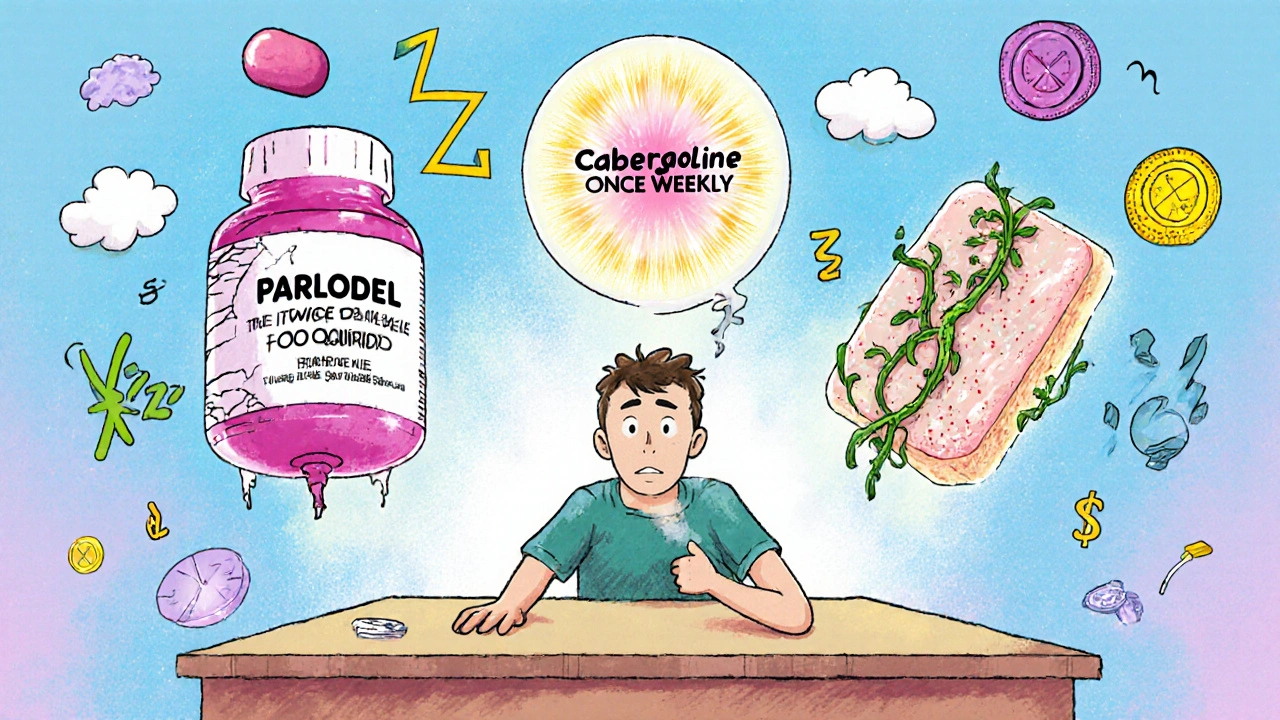Parlodel (bromocriptine) has been used for decades to treat high prolactin levels, Parkinson’s disease, and even type 2 diabetes. But it’s not the only option anymore. Newer drugs are showing better results with fewer side effects. If you’re taking Parlodel-or your doctor suggested it-you deserve to know what else is out there, and whether switching might help you feel better.
What Parlodel Actually Does
Bromocriptine, sold as Parlodel, is a dopamine agonist. That means it tricks your brain into thinking dopamine is present. Dopamine is a chemical that controls movement, mood, and hormone balance. In people with high prolactin, bromocriptine tells the pituitary gland to stop making too much of it. In Parkinson’s, it replaces some of the dopamine the brain has lost.
It’s been around since the 1960s. The FDA approved it for prolactinomas in 1978 and for Parkinson’s in 1984. But back then, there weren’t many alternatives. Today, we have drugs that are more targeted, longer-lasting, and gentler on the body.
Why People Look for Alternatives
Many people stop taking Parlodel because of side effects. Nausea, dizziness, low blood pressure, and fatigue are common. Some report hallucinations or sudden sleep attacks. These aren’t rare-they happen in up to 30% of users. For people with Parkinson’s, the effects can wear off quickly, leading to unpredictable symptoms.
Another issue: Parlodel must be taken with food to reduce stomach upset. That’s inconvenient. And because it’s short-acting, you often need to take it two or three times a day. That makes it harder to stick with long-term.
Top Alternatives to Parlodel
Here are the three most common and effective alternatives, each with different strengths.
1. Cabergoline (Dostinex)
Cabergoline is now the first-choice drug for high prolactin levels. It’s stronger, lasts longer, and causes fewer side effects than bromocriptine. One study in the Journal of Clinical Endocrinology & Metabolism found that 87% of patients with prolactinomas normalized their hormone levels with cabergoline, compared to 67% on bromocriptine.
It’s taken just once or twice a week. No need to time it with meals. Side effects are milder: occasional nausea or dizziness, but rarely severe. For women trying to get pregnant after a prolactinoma diagnosis, cabergoline is the go-to-it’s safer and more effective.
2. Pramipexole (Mirapex)
For Parkinson’s disease, pramipexole is often preferred over Parlodel. It’s a selective dopamine D2/D3 receptor agonist, meaning it targets the brain areas most affected by Parkinson’s without overstimulating others. That reduces nausea and low blood pressure.
It’s taken once daily. Many patients report better motor control and fewer ‘off’ periods-times when medication wears off and symptoms return. A 2023 meta-analysis in Neurology showed pramipexole improved daily function scores by 32% more than bromocriptine over six months.
Downside: It can cause impulse control disorders. Some people develop compulsive gambling, shopping, or eating. This happens in about 8% of users, so it’s important to monitor behavior closely.
3. Ropinirole (Requip)
Ropinirole is another Parkinson’s favorite. Like pramipexole, it’s longer-lasting and more targeted than bromocriptine. It’s available as an immediate-release tablet (taken three times a day) or extended-release (once daily).
Studies show it’s just as effective as levodopa (the gold standard) for early-stage Parkinson’s, but with fewer long-term movement side effects like dyskinesia. It’s also used off-label for restless legs syndrome.
Side effects include drowsiness and swelling in the legs. Rarely, it causes sudden sleep episodes-so don’t drive until you know how it affects you.
What About Newer Options?
There are also newer dopamine agonists like rotigotine (Neupro patch) and apomorphine (injection or pen). These aren’t typically first-line for prolactin, but they’re useful for Parkinson’s patients who can’t swallow pills or need continuous dopamine delivery.
The rotigotine patch delivers medication through the skin over 24 hours. It avoids the digestive system, which helps people with nausea or stomach issues. But it can cause skin irritation. Apomorphine is used for sudden ‘off’ episodes-it works in minutes but requires training to use safely.

When to Stick With Parlodel
Parlodel isn’t obsolete. It still has a role. If you’re pregnant or planning to be, bromocriptine is sometimes preferred over cabergoline because more long-term safety data exists for pregnancy. It’s also cheaper-often under $10 a month with insurance.
Some people respond better to bromocriptine. If you’ve tried cabergoline and it didn’t work, or caused side effects, going back to Parlodel might be the right move. Your doctor might also choose it if you have liver problems-cabergoline is processed more heavily by the liver.
Cost and Accessibility
Parlodel (bromocriptine) is available as a generic. A 30-day supply costs about $15-$25 in the U.S. Cabergoline is more expensive-$80-$120 for 30 tablets-but many insurance plans cover it for prolactinomas. Pramipexole and ropinirole range from $40-$100 depending on dose and formulation.
In Australia, PBS subsidizes bromocriptine and cabergoline for approved uses. You’ll pay around $7-$30 per script. Pramipexole is also subsidized for Parkinson’s but not for prolactin. Always check with your pharmacist.
How to Decide What’s Right for You
Here’s a quick decision guide:
- High prolactin, no Parkinson’s? Start with cabergoline. It’s more effective and easier to take.
- Parkinson’s, early stage? Pramipexole or ropinirole are better choices than Parlodel.
- Need cheap and proven? Bromocriptine still works-especially if you’re on a tight budget or pregnant.
- Have nausea or stomach issues? Try the rotigotine patch or switch to pramipexole.
- Experienced sudden sleep attacks or impulse control issues? Talk to your doctor about reducing dose or switching.
Never stop or switch medications without medical supervision. Abruptly stopping dopamine agonists can cause withdrawal symptoms like fever, muscle stiffness, or confusion.

What to Ask Your Doctor
If you’re considering a change, bring these questions:
- Is my condition better managed with a longer-acting drug?
- Have I been tested for impulse control issues?
- Could my side effects be reduced by switching?
- Is there a generic version of the alternative I’m considering?
- Will my insurance cover the switch?
Bring your current pill bottles or a list of doses. Many doctors don’t realize how often Parlodel is still prescribed when better options exist. Be prepared to ask for a second opinion if you feel unheard.
Final Thoughts
Parlodel saved lives. But medicine has moved on. For most people with high prolactin or Parkinson’s, newer dopamine agonists offer better control, fewer side effects, and simpler dosing. That doesn’t mean Parlodel is bad-it just means it’s not always the best choice anymore.
If you’ve been on it for years and feel fine, great. But if you’re struggling with nausea, fatigue, or inconsistent results, it’s worth exploring alternatives. You might find relief you didn’t know was possible.
Is Parlodel still commonly prescribed today?
Yes, but less often than before. For prolactinomas, cabergoline is now the first-line treatment in most guidelines. Parlodel is still used when patients can’t tolerate cabergoline, need a cheaper option, or are pregnant. For Parkinson’s, it’s rarely the first choice anymore due to better alternatives like pramipexole and ropinirole.
Can I switch from Parlodel to cabergoline on my own?
No. Switching dopamine agonists requires careful planning. Stopping bromocriptine suddenly can cause withdrawal symptoms like high fever, muscle rigidity, or confusion. Your doctor will likely reduce your Parlodel dose slowly while gradually introducing cabergoline. This process usually takes 1-2 weeks.
Do any of these drugs cause weight gain?
Parlodel and cabergoline are more likely to cause weight loss or no change. Some people with high prolactin gain weight before treatment, and losing that weight is common after hormone levels normalize. Pramipexole and ropinirole can cause weight gain in a small number of users-possibly due to improved appetite or reduced movement. Monitoring your diet and activity helps.
Are there natural alternatives to Parlodel?
No. There are no proven natural substitutes that lower prolactin or treat Parkinson’s like dopamine agonists do. Some supplements like vitamin B6 or chasteberry are promoted online, but studies show they’re ineffective for medical conditions. Relying on them instead of prescribed medication can be dangerous.
How long does it take for alternatives to start working?
For prolactin reduction, cabergoline usually lowers levels within 2-4 weeks. For Parkinson’s symptoms, pramipexole and ropinirole may take 2-6 weeks to show full benefit. Don’t expect instant results. Patience and consistent dosing are key.
Next Steps
If you’re on Parlodel and not happy with how you feel, schedule a conversation with your doctor. Bring this article. Ask for a review of your current treatment. If your doctor is resistant, ask for a referral to an endocrinologist or neurologist who specializes in movement disorders. You deserve a treatment plan that works well and fits your life.

Sonia Festa
Parlodel? More like Par-lame. I switched to cabergoline last year and my prolactin levels dropped like a rock. No more 3x-a-day pill schedule, no nausea, and I actually slept through the night. Why are doctors still prescribing this dinosaur?
John Rendek
Good breakdown. I’ve been on ropinirole for 5 years with Parkinson’s. The extended-release version changed my life. No more midday crashes. Just wish more docs knew about it.
Ryan Tanner
Big thumbs up for the rotigotine patch. My mom couldn’t swallow pills after her stroke. The patch? Lifesaver. Skin irritation? Yeah, but we rotate sites and it’s fine.
Emily Barfield
It’s fascinating how medicine evolves, yet we cling to the familiar like a security blanket. Bromocriptine was revolutionary in 1978 - but now? It’s a relic of a time when we didn’t have the tools to be gentle. We don’t just need better drugs - we need a cultural shift in how we view treatment. Is comfort worth suffering? Is convenience worth control? And who decides what ‘better’ even means? The patient? The insurer? The FDA? The answer, I suspect, lies somewhere in the silence between the prescription and the pill bottle.
Amina Kmiha
EVERYONE knows cabergoline is just a gateway drug for Big Pharma to lock you in. They’re hiding the truth - dopamine agonists are designed to make you dependent. The ‘side effects’? That’s your body screaming. And the patch? It’s a tracking device. I’ve seen the patents - they’re embedding microchips. Don’t trust the ‘science’ - it’s all a lie. 🤫👁️💊
Sara Allen
why is everyone so obsessed with switching? i been on parlodel for 12 years and i feel fine. my doctor says if its not broke dont fix it. also cabergoline is way too expensive and i dont trust indian drugs. also why are there so many options? its confusing. just give me my pills and shut up. i dont need a lecture. also i hate when people say ‘you deserve better’ like im some kind of victim. im fine. stop telling me what to do.
Sai Ahmed
Did you know that the FDA approved bromocriptine because it was cheap and easy to mass produce? They didn’t care about side effects. The real reason cabergoline is promoted? Lobbying. Big Pharma paid off the neurology associations. Look at the funding sources on those ‘studies’. And don’t get me started on the sleep attacks - they’re not accidents. They’re controlled. They’re testing how far we’ll go before we stop asking questions.
Jessica Adelle
It is, with the utmost gravity, an abhorrent dereliction of professional and moral duty for any physician to recommend the discontinuation of a time-tested, rigorously vetted pharmaceutical agent such as bromocriptine in favor of newer, less-studied alternatives. The precedent set by such recommendations undermines the sanctity of evidence-based medicine and invites reckless experimentation upon vulnerable populations. One must not confuse novelty with efficacy, nor convenience with cure. The patient’s well-being is not a marketplace. It is a covenant. And to treat it otherwise is not merely irresponsible - it is unethical.